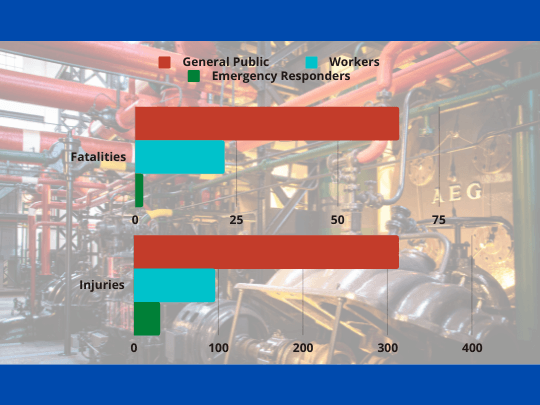Pipeline explosions are, thankfully, fairly rare occurrences. Most pipeline operators, construction crews, and third-party contractors are able to reduce the risk of accidents by implementing and following proper safety protocols. However, when precautions are not taken or a utility cuts corners to prioritize profits, disasters can occur. In this article, we discuss the three most destructive pipeline explosions (in terms of casualties) that occurred in the United States between the years 2010 and October of 2021.
1. San Bruno Pipeline Explosion
On September 9th, 2010, a San Bruno neighborhood was rocked by an immense explosion that claimed eight lives and caused an additional 51 injuries. 38 homes were destroyed in the blast and ensuing fire, and another 70 homes were damaged. The cause of the blast was determined to be a Pacific Gas and Electric Company (PG&E) pipeline that had numerous flaws, including several defective welds. The utility’s records indicated that the flawed section of pipe was seamless, when in fact it was a haphazardly welded collection of pipe segments placed in 19956.
Less than an hour before the explosion, technicians at the natural gas terminal in Milpitas became aware of an electrical failure that led to an unwanted increase in pressure to Line 132. Pressure quickly built up, causing alarms to go off. Some of the sensors that monitor pressure were also knocked out, causing PG&E employees to struggle to understand how quickly pressure was rising. The problem was not corrected quickly enough, and the defective pipe exploded under the rising pressure.
Following the accident, PG&E was convicted on six felony counts, including the breaking of federal gas pipeline laws and obstruction. The company was sentenced to five years of criminal probation and a $3 million fine.
2. East Harlem Gas Explosion
In 2014, several unsafe conditions culminated in one of New York State’s worst gas-related incidents. A pipeline explosion and resulting fire destroyed two five-story buildings in Manhattan, causing eight fatalities and an additional 48 injuries. The National Transportation Safety Board (NTSB) investigated the incident and reported that a faulty connection between two Consolidated Edison Inc gas pipes likely caused the explosion. Additionally, New York City authorities were aware of a hole in a nearby sewer line that may also have played a role in the deadly blast. Had residents alerted authorities of the possibility of a leak and Consolidated Edison Inc called the fire department as soon as it became aware of an issue, NTSB believes that the incident could have been avoided.
After the incident, a settlement of $153.3 million was reached between New York State and Consolidated Edison Inc. Some of the settlement funds were allocated towards systemic improvements to the pipeline network, improving leak response times, and compensating those injured in the blast. Nevertheless, the utility did not admit to causing or influencing the explosion, nor to breaking any local or federal regulations.
3. Merrimack Valley Gas Explosions
A series of natural gas explosions and fires tore through three towns in Merrimack Valley in 2018, causing one fatality and a further 25 injuries. The situation was so dire that Massachusetts Governor Charlie Baker declared a state of emergency the day after the explosions. Undamaged homes in the afflicted towns were left without gas, heat, and hot water for up to three months, in some instances.
An NTSB investigation found that the region’s natural gas distribution system had been over-pressurized, without adequate safeguards and protective measures in place. Additionally, Columbia Gas of Massachusetts improperly abandoned a cast iron pipe without ever redirecting sensing lines to the new polyethylene main. This flawed construction project fatally compromised the system.
Who is Most Impacted by a Pipeline Explosion?
Contrary to popular belief, most of the victims of pipeline explosions over the past decade have been members of the general public. Drawing upon data gathered in the Doan Law Firm’s in-depth study on U.S. pipeline explosions, we can see that they suffered the brunt of both injuries and fatalities caused by pipeline blasts. In fact, an average person is ten times more likely to suffer injury than an emergency responder.

Stay Aware of the Symptoms of a Gas Leak
Many pipeline explosions are preventable with proper precautions and safety measures. If you become aware of anything out of the ordinary, whether at home, at work, or in the community, it’s important to alert the authorities and get to safety at once. Some of the warning signs of a leak include:
- An unusual scent of petroleum or natural gas
- Hissing or roaring noises (the sound may vary depending on the size of the leak and your proximity to it)
- Fire emerging from the ground and burning aboveground, vaporous fogs, or an oily sheen on puddles or other water surfaces
When in doubt, vacate the area and call your local emergency services as soon as you safely can.